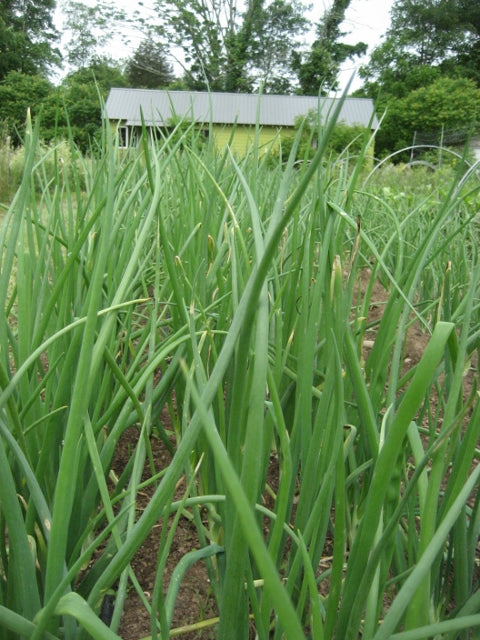 Welcome to May. Spring has taken its time this year, perhaps intimidated by following in the steps of winter’s powerful act. Peas could not be sown on their traditional mid-March date because the ground was still deeply frozen. Spring woodland ephemerals like skunk cabbage and trout lilies came up weeks after they were expected. And, although the magnolias and fruit trees are covered in showy blossoms, most trees are only now considering the prospect of growing new leaves. But, despite this bumpy, cold start, May marks the beginning of late spring, the last period of vernal activities before a summer pace sets over the garden. May brings warmer weather and longer days and with a few good showers (hopefully!), makes for some of the most ideal growing conditions of the year. Expect all plants in your life, wanted an unwanted, to go through a significant growth spurt in the next few weeks.
Welcome to May. Spring has taken its time this year, perhaps intimidated by following in the steps of winter’s powerful act. Peas could not be sown on their traditional mid-March date because the ground was still deeply frozen. Spring woodland ephemerals like skunk cabbage and trout lilies came up weeks after they were expected. And, although the magnolias and fruit trees are covered in showy blossoms, most trees are only now considering the prospect of growing new leaves. But, despite this bumpy, cold start, May marks the beginning of late spring, the last period of vernal activities before a summer pace sets over the garden. May brings warmer weather and longer days and with a few good showers (hopefully!), makes for some of the most ideal growing conditions of the year. Expect all plants in your life, wanted an unwanted, to go through a significant growth spurt in the next few weeks.
Mind the frosts (the heat too): Our last frost date falls right around Mother’s Day (you can check yours here), which means it should be safe to transplant or sow all tender crops after then. But, be sure the weather outside matches calendar’s sentiment on paper: A frost in late May is not unheard of in our region and beyond. To prepare yourself and your tender seedlings, read our article on late frost: Frost? Don’t Freak Out.
If cold isn’t an issue, but the rain won’t stop, better to hold off on transplanting young plants, especially moisture sensitive ones like tomatoes, peppers, and eggplants. To buy a little more time in the greenhouse/windowsill, see Doug’s video tutorial on potting-up tomatoes.
Cold-frames and plastic row covers are great for keeping plants warm on cold nights and speeding up growth (and thus, time till first harvest!), but on the hotter days, the extra layers could start to cook some varieties. If it’s warm and sunny, open up the glass/plastic at least part of the way to create airflow and lower the temperatures.
Hardening off: Seedlings that have been raised in a cozy indoor environment need time to adjust to the elements. Before transplanting into your garden, bring them out during the day, and back in at night for a few days so they can get used to the new temperatures and wind gradually.
Transplanting: After hardening off, it’s time to transplant your tender crops into the garden. Read Transplanting and Troubleshooting for our tips on this process.
 Bed prep: After mid-May, with the frost date behind us, all areas of the garden are fair game. There is still plenty to sow directly, and all of the tender transplants are ready to move out to the garden. Are your beds ready for this sudden population boom? Take a look at this article on spring-time garden prep to keep plants healthy and happy: Four Ways to Spring Clean Your Garden.
Bed prep: After mid-May, with the frost date behind us, all areas of the garden are fair game. There is still plenty to sow directly, and all of the tender transplants are ready to move out to the garden. Are your beds ready for this sudden population boom? Take a look at this article on spring-time garden prep to keep plants healthy and happy: Four Ways to Spring Clean Your Garden.
Weeding: Everything is about to take advantage of the warmth and light and grow, grow, grow. Weeds are, by no means, an exception. Take a look at a few of our tips on efficient weeding. And, a few ideas for how to make use of these "pesky" plants in the kitchen.
Succession: May is also a good month to start a succession plan for greens, herbs, carrots, beets, and radishes. Learn how to sow for a steady harvest.
Direct sow: It’s hard to find a more exciting month than May for direct sowing opportunities in a northern garden. It’s not too late for wide array of spring crops, it’s just the right time for tender summer crops like corn and beans, and it’s not too early to start thinking about long season items like Brussels sprouts for the fall garden. Crops that can be sown in the coming month include: beets, broccoli, carrots, summer squash, fennel, kale, collards, chard, beans, kohlrabi, lettuce, winter squash, radishes, green onions, spinach, cabbage, turnips, rutabagas, cucumbers, corn, watermelons and melons, all tender herbs (like basil).





